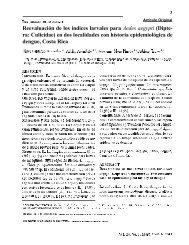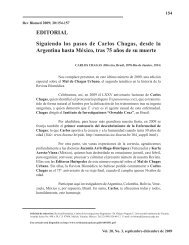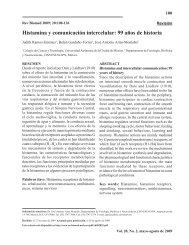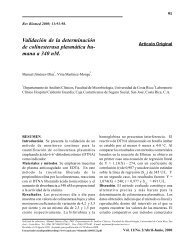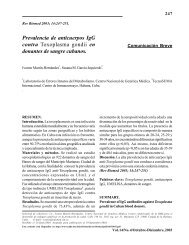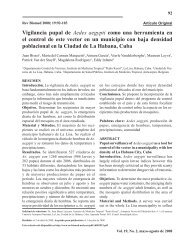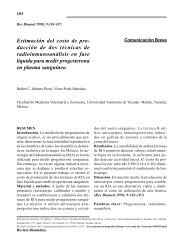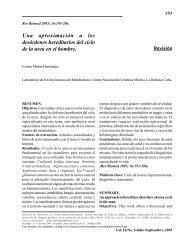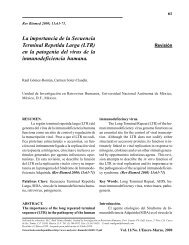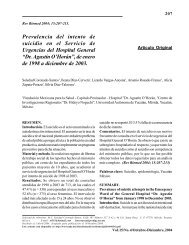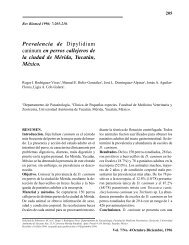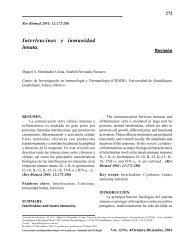La Fiebre Amarilla en Yucatán durante las épocas precolombina y ...
La Fiebre Amarilla en Yucatán durante las épocas precolombina y ...
La Fiebre Amarilla en Yucatán durante las épocas precolombina y ...
You also want an ePaper? Increase the reach of your titles
YUMPU automatically turns print PDFs into web optimized ePapers that Google loves.
302<br />
RA Góngora-Biachi.<br />
Palabras clave: fiebre amarilla, epidemias, Yucatán,<br />
Historia de la Medicina.<br />
Key words: Yellow fever, epidemics, Yucatan,<br />
History of Medicine.<br />
SUMMARY.<br />
The yellow fever in Yucatan before Columbus<br />
period and colonial period.<br />
Yellow fever is a haemorrhagic fever<br />
syndrome caused by a flavivirus, the yellow fever<br />
virus, which is transmitted by the Aedes aegypti<br />
and Haemagogus mosquitoes. The Yellow fever<br />
virus has caused important epidemics in America,<br />
Africa and Europe. The Popol-Vuh, the sacred<br />
book of the mayan indians, relates how yellow<br />
among the mayans was due to their living in close<br />
proximity to monkeys and tells of a sickness called<br />
"xekik" (vomitting blood) which ocurred betwe<strong>en</strong><br />
1480 and 1485. Other sacred texts such as the<br />
Chilam Balam of Chumayel, Tizimín and Kaua also<br />
described the epidemics of "xekik". Fray Diego de<br />
<strong>La</strong>nda, in his book Relación de <strong>las</strong> Cosas de<br />
Yucatán, writt in 1560, refers to the first epidemic<br />
in the region which ocurred approximately from<br />
1483 to 1484. There were epidemics of yellow<br />
fever in 1569 and 1571-1572 described as the<br />
“peste”. The impact of these epidemics, added to<br />
other pathologies imported by the Europeans (small<br />
pox, measles and “tabardillo” (exantematic tifus))<br />
and starvation by plagues and droughts, caused the<br />
indig<strong>en</strong>ous population to be reduced by one third<br />
by 1572. Other yellow fever ocurred in 1648-1650<br />
and in 1699. The 1648 outbreak of the yellow fever<br />
epidemic was described by Fray Diego López<br />
Cogolludo, in his “Historia de Yucatán”, writt<strong>en</strong><br />
in 1688. The epidemic predominated in the region<br />
for two years and its effect was so devasting that<br />
the agricultural activity collapsed, in 1650 there<br />
was famine and the communities were abandoned<br />
as the mayans fleed to the jungle ot the coast.<br />
Yellow fever in Yucatan was th<strong>en</strong> <strong>en</strong>demic.<br />
However, four more outbreaks occurred in 1699,<br />
1715, 1730 and in 1744.<br />
(Rev Biomed 2000; 11:301-307)<br />
Revista Biomédica<br />
INTRODUCCIÓN.<br />
<strong>La</strong> fiebre amarilla es un síndrome de fiebre<br />
hemorrágica ocasionada por un flavivirus, el virus<br />
de la fiebre amarilla, y que es transmitido por los<br />
mosquitos Aedes aegypti y Haemagogus (1). El<br />
virus de la fiebre amarilla ha causado epidemias<br />
importantes <strong>en</strong> el contin<strong>en</strong>te americano, Africa y<br />
Europa. El periodo de incubación de este virus es<br />
de 3 a 6 días, ocasiona una mortalidad de 20%, no<br />
ti<strong>en</strong>e prefer<strong>en</strong>cia por edades ni por género. Posterior<br />
al periodo de incubación la <strong>en</strong>fermedad se manifiesta<br />
por ictericia, hemorragias, vómitos negros,<br />
anuria y delirio final, ocasionado por la necrosis<br />
hepática que ocasiona esta fiebre hemorrágica (1).<br />
Desde marzo de 1923 y hasta la fecha se considera<br />
erradica de México (2).<br />
El virus de la fiebre amarilla ti<strong>en</strong>e un ciclo<br />
selvático y un ciclo urbano. En el ciclo selvático<br />
participan los monos y los mosquitos Aedes <strong>en</strong><br />
África y los mosquitos Haemagogus <strong>en</strong> <strong>las</strong> selvas<br />
tropicales americanas. Aunque <strong>en</strong> la época <strong>precolombina</strong><br />
ya se describían casos de fiebre amarilla<br />
<strong>en</strong> América, debe atribuirse estos casos al ciclo<br />
selvático y <strong>las</strong> epidemias ocasionadas <strong>durante</strong> el<br />
periodo de la conquista europea y la época colonial<br />
se atribuy<strong>en</strong> a la importación al nuevo mundo<br />
del A. Aegypti, vector que ha sido el causante de<br />
los brotes urbanos (3).<br />
LA FIEBRE AMARILLA EN LA ÉPOCA<br />
PRECOLOMBINA.<br />
El Popol-Vuh, libro sagrado de los mayas<br />
quichés, relata que la fiebre amarilla <strong>en</strong>tre los mayas<br />
se debe a la constante conviv<strong>en</strong>cia con los<br />
monos y relata la epidemia de una <strong>en</strong>fermedad llamada<br />
xekik (vómito de sangre) ocurrida <strong>en</strong>tre los<br />
años de 1480 a 1485 (3). Interesantem<strong>en</strong>te y con<br />
una anticipación de más de quini<strong>en</strong>tos años del<br />
descubrimi<strong>en</strong>to del A. Aegypti como el vector de



